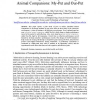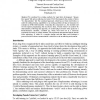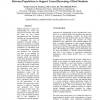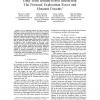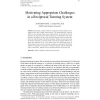AIED
2005
Springer
14 years 5 months ago
2005
Springer
Abstract. We built three different versions of an ITS on a letter pattern extrapolation task: in one version, students only receive color-coded feedback; in the second, they receiv...
AIED
2005
Springer
14 years 5 months ago
2005
Springer
This paper reports a pilot study of how to utilize simulated animal companions to encourage students to pay more effort in their study in the classroom environment. A class of stud...
AIED
2005
Springer
14 years 5 months ago
2005
Springer
Learning Object Metadata (LOM) intends to facilitate the retrieval and reuse of learning material. However, the fastidious task of authoring them limits their use. Motivated by thi...
AIED
2005
Springer
14 years 5 months ago
2005
Springer
We combined two existing methods for rapid tutor development: “plug-in tutor agents” [6] and an authoring tool suite (CTAT) that supports the creation of tutors “by demonstra...
AIED
2005
Springer
14 years 5 months ago
2005
Springer
Making inferences is crucial for understanding the world. The school may develop such skills but there are few formal opportunities for that. This paper describes an experiment de...
AIED
2005
Springer
14 years 5 months ago
2005
Springer
In this paper, we show how using data mining algorithms can help discovering pedagogically relevant knowledge contained in databases obtained from Web-based educational systems. Th...
AIED
2005
Springer
14 years 5 months ago
2005
Springer
— As an increasing number of robots have been designed to interact with people on a regular basis, research into human-robot interaction has become more widespread. At the same t...
AIED
2005
Springer
14 years 5 months ago
2005
Springer
This paper presents the EarthTutor authoring tool, a multi-layered system designed to remove the technical hurdles preventing teachers from having full control over the structure o...
AIED
2005
Springer
14 years 5 months ago
2005
Springer
An important but often neglected aspect in Computer Supported Collaborative Learning is the intelligent formation of learning groups. Until recently, support for group formation wa...
AIED
2005
Springer
14 years 5 months ago
2005
Springer
Abstract. Formalizing a student model for an educational system requires an engineering effort that is highly domain-specific. This model-specificity limits the ability to scale ...

